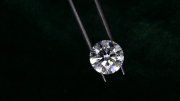As a child, Robert C. “Bob” Hagemann, M.B.A. ’11, would go out into his garage and break the Styrofoam in the trash into little pieces. “My mom would come out into the garage and ask, ‘What are you doing?’ And I looked at her and I said, ‘I’m starting the process of trying to break these down,’” he recalled. “I always have been very in touch with nature and the planet and the impacts that my choices—and other people’s choices—can have.”

Bob Hagemann
Photograph courtesy of Bob Hagemann
Hagemann’s environmental awareness has now crystallized into Aether Diamonds, which the entrepreneur and marketing expert helped co-found last year after selling his craft-spirits business. According to Aether, which raised $2.6 million in its seed round of funding, and employs seven people full-time, it is the first company to fashion certified, gemstone-quality diamonds out of air. Using its proprietary technology, the nascent luxury brand pulls carbon dioxide from the atmosphere, converts the greenhouse gas into the hydrocarbon methane, and then feeds this freshly synthesized raw material into a reactor. There, over the course of three to four weeks of a chemical vapor-deposition procedure, the carbon atoms are formed into precious stones.
The distinction between Aether diamonds and their natural counterparts is neither optical nor chemical—they are certified by the International Gemological Institute and held to the same standards as mined diamonds—but rather ethical. For each carat Aether produces, the company pledges to remove 20 metric tons of carbon dioxide from the atmosphere with its signature direct air capture, as well as supplemental processes like geological sequestration, mineral sequestration, and reforestation. (Only a fraction of the carbon is sequestered “forever” in its diamonds, though; the majority is stored as liquid methane in tanks.)
While Aether removes enough carbon dioxide to offset the average American’s annual carbon footprint with each carat it makes, traditional diamond mining has a “disastrous” impact on the Earth, Hagemann said. He cited the dynamite and drilling that uproot hundreds of tons of earth, the heavy machinery that pumps pollutants into the air, and the acid mine-runoff that damages ecosystems. Many mine operators are also responsible for human-rights abuses and hazardous working conditions, he added—“not to mention that a lot of the money that goes into the diamond industry from consumers gets funneled back to corrupt military governments.” (To read more about the international impact of extractive industries, see this article about Fevers, Feuds, and Diamonds: Ebola and the Ravages of History.)
The generation of lab-grown diamond companies that preceded Aether took a step in the right direction, Hagemann said, but they haven’t shifted the paradigm to the extent the climate crisis demands. “Lab-grown diamonds, in general, are not as clean as everybody thinks they are,” he explained, noting that Aether’s lab-grown competitors source the raw material used to make their products from fossil fuels.
By sourcing its carbon from pollution in the air—and powering its reactors with sustainably sourced energy—Hagemann said Aether’s diamonds are as clean as advertised. “We created the world’s first truly sustainable diamond,” he said. “We’re basically cleaning up all of the emissions that have been released into the atmosphere—not just historically by the diamond industry, but by anybody else who’s polluting.”
This narrative gets more complicated when considering the company’s logistics writ large, however. Though its stones are carbon-negative, Aether as a whole is carbon-neutral, he acknowledged. That means the rest of the operation releases some of the same type of emissions that its diamonds clean up. Those emissions occur as a result of shipping to customers, use of electricity in staff office space, and transport of materials between the stages of production. Aether is headquartered in New York City, but its diamonds are made in a lab in Chicago, and it works with a carbon-capture company in Switzerland.
“Our goal is to be a carbon-negative company,” Hagemann said. By 2023, he envisions Aether being well on its way toward doing production onsite, harnessing its own renewable sources of wind and solar power, and sending excess energy back to the grid.
Hagemann said he could not disclose how much energy the reactors use due to “competitor concerns.” He did note, however, that Aether has “figured out a way to ensure that the reactors don’t require as much energy input to begin with, compared to some of the other lab-grown brands out there.”
On the subject of competitors, Hagemann said Aether would be willing to license its patented technology to other companies. “Our goal is not to become hoarders or be the only company that can ever make diamonds out of air or air pollution,” he said. “Our goal, despite the fact that we do have these [patent] protections in place, is to allow the diamond industry to grow and progress, and we are more than happy to license out that technology and those capabilities to brands who want to follow in our footsteps.”
Aether may be in the process of redefining the diamond industry, but it still conforms to consumer expectations. Jewelry brands are not mining a natural phenomenon when they equate diamonds and devotion, after all. This link—and the popularity of diamond rings—were lab-grown in a 1940s marketing program by the diamond company De Beers—the campaign that originated the canonical tagline, “A diamond is forever.”
“While, yes, the traditional diamond industry was developed from a marketing standpoint, what we hope to do in disrupting…and redefining the diamond industry is giving people a different or a new reason to want a diamond—which is that it can represent or be a symbol of your commitment to a better future, or to a healthier planet,” Hagemann said. “That, for me at least, can serve as a rationale and as a really exciting reason to want a diamond.”
Deploying the marketing expertise he learned at Harvard Business School and during his time consulting with prominent brands (including Chanel, Tiffany, Burberry, Jimmy Choo, Lamborghini, Google, and Apple), Hagemann hopes to usher today’s “value-aligned” consumers toward a product they can be “proud about wearing.”
This messaging seems effective: within five months of going live with its products in December 2020, Aether received so much interest that it had to institute a waitlist. The company is now working to fulfill more than 175 pre-orders, some from customers who “never previously considered buying a diamond because of the environmental impact.” With Aether’s diamond products priced between approximately $4,000 and $40,000, that initial set of orders totals more than $3 million of pending sales.
“I never expected to be an entrepreneur,” Hagemann reflected, recalling how he once thought his business school classmates with entrepreneurial aspirations were “crazy.” But, he continued, “Over the years what I found was that I was so drawn to the idea of creating something new and making an impact with a project that I led or thought of that those fears sort of fell away. And the risks became things that were maybe a little bit more exciting.”









